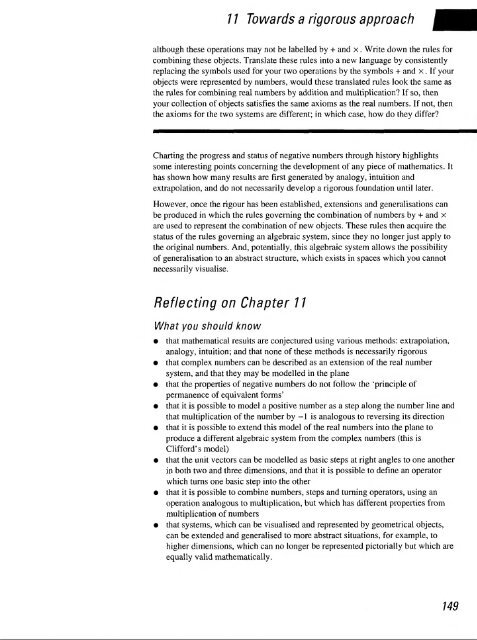history of mathematics - National STEM Centre
history of mathematics - National STEM Centre
history of mathematics - National STEM Centre
Create successful ePaper yourself
Turn your PDF publications into a flip-book with our unique Google optimized e-Paper software.
7 / Towards a rigorous approach<br />
although these operations may not be labelled by + and x. Write down the rules for<br />
combining these objects. Translate these rules into a new language by consistently<br />
replacing the symbols used for your two operations by the symbols + and x. If your<br />
objects were represented by numbers, would these translated rules look the same as<br />
the rules for combining real numbers by addition and multiplication? If so, then<br />
your collection <strong>of</strong> objects satisfies the same axioms as the real numbers. If not, then<br />
the axioms for the two systems are different; in which case, how do they differ?<br />
Charting the progress and status <strong>of</strong> negative numbers through <strong>history</strong> highlights<br />
some interesting points concerning the development <strong>of</strong> any piece <strong>of</strong> <strong>mathematics</strong>. It<br />
has shown how many results are first generated by analogy, intuition and<br />
extrapolation, and do not necessarily develop a rigorous foundation until later.<br />
However, once the rigour has been established, extensions and generalisations can<br />
be produced in which the rules governing the combination <strong>of</strong> numbers by + and x<br />
are used to represent the combination <strong>of</strong> new objects. These rules then acquire the<br />
status <strong>of</strong> the rules governing an algebraic system, since they no longer just apply to<br />
the original numbers. And, potentially, this algebraic system allows the possibility<br />
<strong>of</strong> generalisation to an abstract structure, which exists in spaces which you cannot<br />
necessarily visualise.<br />
Reflecting on Chapter 11<br />
What you should know<br />
• that mathematical results are conjectured using various methods: extrapolation,<br />
analogy, intuition; and that none <strong>of</strong> these methods is necessarily rigorous<br />
• that complex numbers can be described as an extension <strong>of</strong> the real number<br />
system, and that they may be modelled in the plane<br />
• that the properties <strong>of</strong> negative numbers do not follow the 'principle <strong>of</strong><br />
permanence <strong>of</strong> equivalent forms'<br />
• that it is possible to model a positive number as a step along the number line and<br />
that multiplication <strong>of</strong> the number by -1 is analogous to reversing its direction<br />
• that it is possible to extend this model <strong>of</strong> the real numbers into the plane to<br />
produce a different algebraic system from the complex numbers (this is<br />
Clifford's model)<br />
• that the unit vectors can be modelled as basic steps at right angles to one another<br />
in both two and three dimensions, and that it is possible to define an operator<br />
which turns one basic step into the other<br />
• that it is possible to combine numbers, steps and turning operators, using an<br />
operation analogous to multiplication, but which has different properties from<br />
multiplication <strong>of</strong> numbers<br />
• that systems, which can be visualised and represented by geometrical objects,<br />
can be extended and generalised to more abstract situations, for example, to<br />
higher dimensions, which can no longer be represented pictorially but which are<br />
equally valid mathematically.<br />
149
















